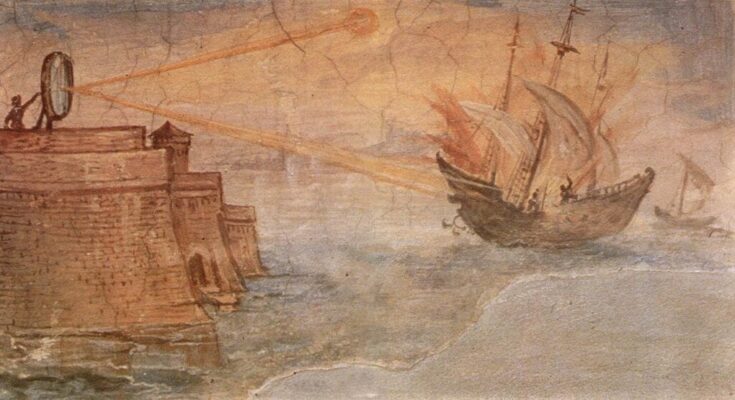
An award-winning 12-year-old schoolboy in Canada has created a working death ray based on the model by ancient Greek philosopher and mathematician Archimedes.
Historians and scientists have deliberated for hundreds of years on whether a “death ray” weapon supposedly invented by the ancient Greek mathematician and physicist Archimedes could have worked.
Now, 12-year-old Canadian schoolboy Brenden Sener has made a replica of the death ray using concave mirrors and LED desk lamps with 50-watt bulbs—and it works.
What was mathematician Archimedes’ death ray?
Archimedes’ death ray is believed to have been used across the sea in battle with Roman invaders during the Siege of Syracuse in 213 BC to 212 BC, supposedly harnessing light from the sun using a series of mirrors and reflecting solar rays back at Roman ships and setting them on fire.
Reflecting sunlight to start fires is not a new concept, but whether the method would have functioned in a battle is something still under discussion. A team of researchers from the Massachusetts Institute of Technology (MIT) previously claimed that the design could set a ship aflame in just eleven minutes. However, others, including French philosopher Rene Descartes, have argued the story of Archimedes’ death ray is implausible, particularly in a battle scenario.
Nevertheless, Sener discovered that the temperature of a target can be raised by two degrees Celsius with each mirror added into the equation, according to IFL Science.
He then reportedly increased the wattage of the LED lamp to 100, and found that the “change in temperature with each mirror was four degrees Celsius up to three mirrors and an additional 10 degrees Celsius with the fourth mirror.”
“Based [on] my experimental findings, i agree with the MIT group and believe that with a strong enough heat source and larger, multiple mirrors all focused at a perfect angle, combustion could be possible,” the 12-year-old school boy wrote.
He added that “the historical descriptions of the use of the death ray in ancient Syracuse is plausible,” but that “no archaeological evidence of the Archimedes death ray has been found besides what is recorded in the books of ancient philosophers.”
Sener has received several awards for his work, including the Matthews Hall Annual Science Fair Gold Medal and the London Public Library Award for Inspiring Children’s Interests in Science and Technology.
Few details are known about the life of ancient Greek mathematician and physicist Archimedes, but he is regarded as one of the leading scientists in classical antiquity. Largely considered the greatest mathematician of ancient history and one of the greatest of all time, Archimedes proved a range of geometrical theorems using methods that would become modern day calculus.



